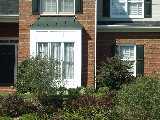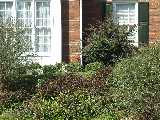Olympus E-10A 4 megapixel sensor and unique SLR optics make for a major coup for Olympus! (Final review, based on full-production model.)<<Reference: Datasheet :(Previous) | (Next): Print-Friendly Review Version>> E10 Sample ImagesReview First Posted: 1/26/2001 |
| We've begun including links in our reviews to a Thumber-generated
index page for our test shots. The Thumber data includes a host of information
on the images, including shutter speed, ISO setting, compression setting,
etc. Rather than clutter the page below with *all* that detail, we're posting
the Thumber index so only those interested in the information need wade
through it! ;) |
|
|
Outdoor
portrait: (1666k) The extreme tonal range of this image makes it a tough shot for many digicams, which is precisely why we set it up this way. The object is to hold highlight and shadow detail without producing a "flat" picture with muddy colors, and the Olympus E-10 SLR handles the challenge nicely. We did feel that the camera could have done a better job of holding highlight detail in the model's shirt though. (A tough task though, which very few digicams seem to manage.) We shot samples of this image with the automatic (1665k) white balance setting, as well as the 4,500 (1646k), 5,500 (1671k), and 6,500 (1641k) degree Kelvin temperature settings. We chose the automatic setting for our main series, due to its more accurate color balance. The 4,500 degree setting produced slightly cool results, while the 5,500 and 6,500 degree settings resulted in warmer images (the 6,500 degree setting being the warmest overall). As we noticed with the prototype model that we tested earlier, the E-10 does a nice job with color. The blue flowers and pants look nearly accurate, though maybe just a touch undersaturated (these blues are somewhat difficult for many digicams to reproduce correctly). The skin tones and red flowers also look nice. Many cameras have trouble with the red flowers, reproducing them a little too bright and with a loss of detail. The E-10 does a great job of keeping the red values in check, as we can see the thread detail on the flower surface. Resolution looks excellent, with a lot of fine detail visible throughout the image. Details also appear very crisp, with defined edges. The shadow areas show a nice level of detail as well, with only a small amount of fine-grained noise present. Our main image was taken with a +0.3 EV exposure adjustment, as the best tradeoff between midtone/shadow levels and highlight detail. The table below shows the results of a range of exposure settings from zero to +1.3 EV. Exposure Compensation Settings:
|
||||||||||||||||||||||
|
|
Closer
portrait: (1675k) The E-10 also performs well with this closer, portrait shot, without any distortion from its 4x lens. (Shorter focal length lenses tend to distort facial features in close-up shots like this and the availability of longer focal lengths is a key feature if you're going to be shooting close-up people shots.) We again shot with the automatic white balance (1632k) setting, but snapped a sample image at the 5,500 degree Kelvin (2314k) setting for comparison. The 5,500 degree setting warms up from its cooler cast in the wider Outdoor portrait, washing out the color balance slightly. Color balance remains nice with the automatic white balance setting, with good skin and hair tones. Resolution and detail look even better in this shot, with practically all the fine details of the face and hair completely visible. We did notice a very slight moiré/aliasing pattern on the sunlit strands of hair, but it was fairly minimal. Noise level remains low and finely grained in the shadow areas. Our main shot was taken with no exposure adjustment, a notch less than in the Outdoor Portrait. (Normally, this close-up shot requires less exposure compensation.) The result is slightly dark in the midtones, but loses a bit less highlight detail. A very good performance overall. The table below shows the results of a range of exposure settings from zero to +1.0 EV. Exposure Compensation Settings:
|
||||||||||||||||||||||
|
|
Indoor
Portrait, Flash: (1634k) The E-10's built-in flash does a fairly good job of illuminating the subject, though the resulting image shows a very warm, orange cast from the household incandescent lighting. For some reason, the E-10's internal flash seems to consistently underexpose the shots when using its default exposure settings. We observed this on the prototype unit we tested, and saw it again in the production model. (For best results, we really advise readers to look toward an external flash device.) We first shot with the E-10's internal flash, with no exposure adjustment at all, which produced this (1617k) reasonably bright image. Despite the warm cast, color is a little undersaturated, and the model's face remains dark. We next shot with the internal flash and a +2.0 EV (1634k) exposure adjustment, which brightened the image and boosted the saturation, though the warm, orange cast remains. Next, we attached an external flash (1638k), and bounced it from the ceiling (disabling the internal flash), which resulted a more accurate color balance. The orange cast is still present, though with a lower intensity, and the bounced light provides more even coverage. Next, we again bounced the external flash from the ceiling, but this time placed a piece of white paper over the flash to serve as diffusion.(1620k) This produced similar results to the previous setup, but dimmed the flash power slightly (mostly noticeable in the model's face). Finally, we bounced the external flash with diffusion, but also enabled the E-10's internal flash, with an intensity setting of -0.7 EV.(1613k) The orange cast is replaced with a slight magenta cast, but the overall lighting and color balance look good and even. The model's shirt and the white flowers have a nice white value, and color saturation looks about right. |
||||||||||||||||||||||
|
|
Indoor
portrait, no flash: (1657k) This shot is always a very tough test of a camera's white balance capability, given the strong, yellowish color cast of the household incandescent bulbs used for the lighting, and the E-10's manual white balance setting did a really excellent job. Color balance is very good, though just a little undersaturated (fairly normal with this shot). The blue flowers also appear slightly dark, shading to purple, again typical given the strong color cast of the scene lighting. Resolution looks great throughout, with a lot of fine detail visible in the flowers and around the model's face. The shadow area of the leafy stems also shows a lot of fine detail. Again, details are very crisp and defined, with the exception of the yellow flowers (which could be soft due to slight movement or limited depth of field due to the wide aperture being used). Noise is present but minimal, maintaining a very fine grain pattern. An excellent performance. The following table shows a range of exposure adjustments from zero to +1.7 EV. Exposure Compensation Settings:
|
||||||||||||||||||||||
|
|
House shot:
(2638k) NOTE that this is the "new" house shot, a much higher-resolution poster than we first used in our tests. To compare the image of the E-10 with previously tested cameras, here's a shot of the original house poster in the automatic (2463k) white balance setting. We shot samples of this image with the 4,500 degree
Kelvin (241k), automatic
(239k), and manual (239k)
white balance settings. The manual setting produced the most accurate
results overall, though the 4500K setting looked pretty good as well,
but a little magenta. Auto was a fairly warm, so we shot our main series
at the 4500 degree Kelvin setting. Color balance looks good overall, though
slightly warm. Resolution looks very good, with the bricks, shrubbery,
and tree limbs showing great detail. The overall image is slightly softer
than our other test shots, possibly due to the clarity of the poster itself.
Still, the image is reasonably sharp. Noise is minimal in the roof shingles
and shadows, again with a very fine grain pattern. Just a trace of a halo
effect around the light and dark edges of the white trim along the roof
line gives away the in-camera sharpening. Overall, though, a very nice
job. Following is a range of resolution and quality settings in the automatic
white balance mode.
|
||||||||||||||||||||||
|
|
Far-Field
Test (1747k) This image is shot at infinity to test far-field lens performance. NOTE that this image cannot be directly compared to the other "house" shot, which is a poster, shot in the studio. The rendering of detail in the poster will be very different than in this shot, and color values (and even the presence or absence of leaves on the trees!) will vary in this subject as the seasons progress. In general though, you can evaluate detail in the bricks, shingles and window detail, and in the tree branches against the sky. Compression artifacts are most likely to show in the trim along the edge of the roof, in the bricks, or in the relatively "flat" areas in the windows. We shot samples of this image with the automatic
(232k) and manual (234k)
white balance settings, as well as the 5,500
(232k), 6,500 (233k),
and 7,500 (232k) degree
Kelvin temperature settings. We chose the automatic setting for our main
series, which produced similar results to the manual and 5,500 degree
Kelvin settings. The 6,500 and 7,500 degree settings produced warmer results.
Color balance looks good, though the overall shot has a hazy appearance.
We noticed this in all the white balance settings except for the 6,500
and 7,500 degree Kelvin shots, whose warmth may have eliminated the hazy
effect. (Rather odd, seems to be primarily an exposure/tonal range issue:
"Auto Levels" in Photoshop(tm) fixed it right up.) This shot
is a strong test of detail, given the practically infinite range of fine
detail viewable in a natural scene like this from a distance. Resolution
looks great, especially in the pine needles and tree branches against
the sky, as well as in the bricks. Though the shrubbery area isn't as
attractive as in spring and summer, you can still detect a lot of fine
detail in the dead leaves and branches. Overall image sharpness looks
good, with crisp details. We also judge a camera's dynamic range in this
shot, comparing how well the camera holds detail in both the shadow and
highlight areas. The E-10 performs reasonably well here, showing the stronger
details in the bright, white bay window area, tricked just slightly by
the brightness. Detail in the darker shadow areas is very good, as we
can just barely see the brick pattern in the shadows of the porch. Noise
in the roof shingles and shadow areas of the house is fairly low and fine-grained,
as we've noticed throughout our testing. The table below shows our resolution
and quality series.
Sharpness Series We also shot with the E-10's sharpness adjustments, which subtly altered the overall image sharpness without noticeably changing contrast or brightness. The only "side-effect" we noticed was that the color balance actually appeared slightly warmer with the Soft setting, and cooler with the Hard setting.
Contrast Series The E-10 also allows you to adjust the image contrast. We noticed that the High contrast setting tended to brighten the overall tonal balance slightly, in addition to increasing the contrast. The Low setting seemed to intensify the milky, hazy effect we noticed in the main Far shot, washing out the color balance slightly. We tried shooting with the contrast set to Low, and the exposure compensation set at -0.7 EV. This dimmed the image, but produced better color saturation.
|
||||||||||||||||||||||
|
|
Lens Zoom Range We've received a number of requests from readers to take shots showing the lens focal length range of those cameras with zoom lenses. Thus, we're happy to present you here with the following series of shots, showing the field of view with the lens at full wide angle, and the lens at full 4x telephoto. We also shot with Olympus' wide angle and 200mm and 400mm telephoto accessory lenses. The normal wide angle shot shows just a small hint of barrel distortion along the curb of the street, which is also present with the wide angle lens attachment. The E-10's 4x telephoto setting sharpens the fine details and increases resolution and color saturation as it zooms in. The 200mm and 400mm attachments also maintain crisp details with increased resolution, with the 400mm lens deepening the color saturation a little more.
|
||||||||||||||||||||||
|
|
Musicians
Poster (2550k) For this test, we shot with the automatic (230k), manual (229k), and 4,500 degree Kelvin (229k) white balance settings, choosing automatic for our main series. The large amount of blue in the image often tricks digicams into overcompensating, and we noticed that the E-10 fell victim to this trap. None of the white balance settings produced a dead-on accurate color balance. Both the manual and 4,500 degree Kelvin settings resulted in a cool image, with the 4,500 degree setting producing slightly magenta tones. The automatic setting produced a slightly warm image, but the skin tones and the Oriental model's blue robe appear nearly accurate. Great resolution, with all of the detail of the bird wings and silver threads on the blue robe visible, including the sometimes difficult color gradations on the wings. A nice amount of fine detail is also visible in the flower garland and beaded necklaces. The violin strings show a slight moiré pattern, but overall, the image is crisp and clear. A minimal amount of noise is present in the blue background and shadow areas, some of which could be coming from the poster itself. This shot again showed the tendency we observed in the far-field shot, for the shadows not to extend to full black, but rather stop somewhere short at a deep gray. The result is a slight milkiness to the image. While it can be easily corrected with an "auto levels" operation in Photoshop, it would be preferable if the camera had used the available tonal range more fully. (Although, given the choice between an camera "plugging" the shadows or leaving them more open as here, we'd vote for the open shadows every time.) Below is our resolution and quality series (this time with the exception of the uncompressed TIFF setting). Resolution/Quality Series
|
||||||||||||||||||||||
|
|
Macro Shot (2434k) The E-10 does an excellent job in the macro category, capturing a minimum area of just 2.88 x 2.16 inches (73.03 x 54.77mm). Detail and resolution both look great. Though the printing detail on the dollar bill is just a little soft, we can still detect the fiber pattern in the bill. The E-10's built-in flash (2624k) does a pretty good job of throttling down for the macro area, though it's tricked by the shiny coin just a little and produces a slightly dim image. |
||||||||||||||||||||||
|
|
"Davebox"
Test Target (2583k) We shot samples of this target using the automatic (267k), 4,500 degree Kelvin (267k), and manual (270k) white balance settings, choosing the automatic setting for our main series. Both the 4,500 degree and automatic white balance settings produced similar results, with just a hint of a magenta cast. The manual setting produced a cooler image, but one in which we felt the overall color balance was more accurate. The large color blocks look nearly accurate, though slightly undersaturated, most noticeable in the bright yellow block. The E-10 has no problem distinguishing the difference between the red and magenta color blocks on the middle, horizontal color chart, which is a common problem area for many digicams. It also reproduces the subtle tonal variations of the Q60 chart well, which are completely visible up to the "B" range (another common problem area for digicams). The tonal gradations of the vertical gray scales also look good, with the darkest two blocks blending together slightly. The shadow area of the briquettes shows excellent detail, with only minimal noise. Detail also looks good in the highlights of the white gauze area. Resolution looks great overall, with a lot of fine detail visible in the hinges and silver disk. The table below shows our resolution and quality series. Resolution/Quality Series
|
||||||||||||||||||||||
|
|
Low-Light Tests The E-10 did a really phenomenal job in the low-light category, as we were able to obtain very bright, usable images at light levels as low as 1/16 of a foot candle (0.67 lux). (The most amazing results we obtained were in a moonlight shot in the back yard. Not one of our standard test images, so not included here, but with a 30 second exposure, the moonlight looked almost like noonday sun, with surprisingly little noise.) Noise levels stayed very low at all three ISO settings. The highest noise level existed at the 320 ISO setting, but was still very minimal and finely grained. (We direct readers to Mike Chaney's excellent Qimage Pro program, for a tool with an amazing ability to remove image noise without significantly affecting detail.) All three ISO settings produced warm, pinkish casts at the lower light levels, which dissipated on average around 1/2 foot candles (5.5 lux). To put the E-10's low light performance into perspective, an average city night scene under modern street lighting corresponds to a light level of about one foot candle, making the E-10 well-equipped for even darker shooting situations. The table below shows the best exposure we were able to obtain for each of a range of illumination levels, at each of the available ISO settings. Images in this table (like all of our sample photos) are untouched, exactly as they came from the camera.
|
||||||||||||||||||||||
|
|
Flash Range Test (This test was added in August 1999, so cameras tested before that time won't have comparison pictures available. As we go forward though, all the new models will have similar tests available). Olympus rates the E-10's flash as effective from 0.6 to 18.3 feet (0.2 to 5.6m), which matches our findings. Though the flash was reasonably effective all the way out to 14 feet, we noticed that it was rather dim at all distances. Unfortunately, our studio isn't long enough to test Olympus' claims of 18.3 feet. This mirrored the results we obtained in the indoor flash shot above, and seems odd: It should just be a matter of calibration of the flash exposure system. Dialing flash exposure compensation up to the limit of +2.0EV largely fixes the problem, but that really shouldn't be necessary on a camera of this caliber. Below is our flash range series, with distances from eight to 14 feet from the target.
|
||||||||||||||||||||||
|
|
ISO-12233
(WG-18) Resolution Test (1546k) As you'd expect, given its 4 megapixel sensor, the E-10 did very well on our resolution test. For now, we took just a single shot in wide-angle mode (generally the best focal length for a zoom lens, we'll fill in with a full resolution series once we get our hands on the production model). The results were very impressive: In the horizontal direction, the E-10 resolved a good 850 lines per picture height before showing any trace of aliasing, and detail was clearly visible well beyond 1000 lines. Vertically the numbers were a bit lower, but still very good, with the first indication of aliasing appearing at about 770 lines per picture height, and good detail visible out to around 950. For those interested, we also shot a sample in the uncompressed TIFF (12071k) mode, but we'd ask that readers not download it unless they really feel a burning need to, as the multiple 12 megabyte(!) downloads really run up our hosting bill... Resolution Series, Wide Angle
Resolution Series, Telephoto
|
||||||||||||||||||||||
|
|
Viewfinder Accuracy/Flash Uniformity We found the E-10's SLR optical viewfinder to be just a little tight, with the frame accuracy varying with image size. At the 2240 x 1680 resolution size, the optical viewfinder showed about 92.9 percent of the final image area at wide angle (2710k), and about 94.7 percent at telephoto.(2489k) At the smaller 1280 x 960 resolution size, the optical viewfinder showed about 93.7 percent of the final image area at wide angle (244k), and about 95.5 percent at telephoto.(241k) We found similar results with the LCD monitor, which also varied in accuracy with the resolution size. The 2240 x 1680 size resulted in approximately 92.9 percent accuracy at wide angle (2691k), and about 94.5 percent at telephoto.(2482k) The 1280 x 960 image size resulted in about 93.6 percent accuracy at wide angle (243k), and about 95.4 percent at telephoto.(239k) Since we generally like to see LCD monitors as close to 100 percent accuracy as possible, the E-10 does a pretty good job, although we'd still like it to be a bit more accurate. (For reference, most film-based SLRs have 95% viewfinders, and that's the accuracy level claimed by Olympus.) Optical distortion on the E-10 is a little high at the wide angle end, as we measured an approximate 0.78 percent barrel distortion there. The telephoto end fared much better, showing virtually no pincushion distortion at all (we actually detected about half a pixel of pincushion distortion, really within the margin of error for measurement). Chromatic aberration is also relatively low, showing about 1.5 pixels of coloration on each side of the black target lines. (This distortion is visible as a very slight colored fringe around the objects at the edges of the field of view on the resolution target.) Flash distribution looks dim but even at the telephoto setting. At the wide angle setting, flash distribution is somewhat blotchy, with the brightest area in the very center of the target and noticeable falloff around the edges and corners. |
||||||||||||||||||||||






Follow Imaging Resource: